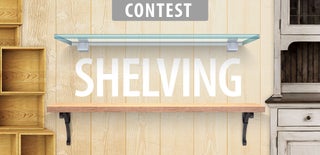Introduction: Reclaimed Wood Shelving
Here are some versions of a shelf I made for my mom and some friends. It is a very simple design idea that you can toy around with and put your own twist on it. The main idea was to use black plumbing and flanges to stack reclaimed barn wood into a shelf. I have now done two different versions with different styles of wood and they seem to have come out great and am working on a few other designs as well. It requires little to know skill or tools to complete this and is a fun project to do.
Step 1: What You Need
Tools:
Electric Drill
Phillips head bit
Drill bit set
Circular saw or table saw
Sander
Planer (only if boards are uneven)
Materials:
3/4" x 18" Black plumbing pipe - 12x
3/4" Flanges - 24x
Reclaimed boards around 8"x1"x48" - 4x
3" Industrial Swivel Caster wheels - 4x
Large box of #10 Flat head Phillips screws 3/4" long
Flat washers(optional)
Tung Oil
Water-based Polyurethane
Step 2: Prepping the Wood
The simple steps I am going to cover here are as follows: getting the right wood, cutting it to size, carefully sanding it, and then applying a tung oil to it before finishing it with a polyurethane coat.
The wood used in the original design is reclaimed barn wood from a friend. Any local wood shop or specialist most likely has in their inventory or atlas access to a style of wood similar because of its popularity. The wood can be as long as you wish, I chose boards that were 1" thick and 8" wide. I then cut the boards down to size using a circular saw. I cut the boards down to 48" long so I could place wider and larger objects onto it. After cutting the boards to size, I used a orbital sander to sand the boards. Lightly sanding from 80 grit to 200 grit, be sure to go lightly to remove splinters but not patina, this is what gives it the rustic look. When working with reclaimed wood, always scan the boards for nails or other forgotten metal pieces left in the wood. Also older wood may have been painted or treated with harsh chemicals or lead based paint so when sanding be sure to wear a mask or have proper ventilation and to carefully clean up all the dust. Next I applied 3 coats of Tung oil to the wood making sure every crevasse was covered. Then to seal everything in I applied a coat of water based polyurethane.
Step 3: Assembly
The assembly is as followed: Layout the shelf how you would like it done, mark the holes and pilot droll the holes for the flanges, start from the bottom up attaching wheels and piping to the boards, display your achievement of awesomeness and reap in the glory from all friends family and random people.
Start by attaching your wheels to the bottom of your bottom board, use washers if necessary. Then attach the pipes to the flanges and tighten all the way. From there place you bottom board on a level ground and build up the shelf layout, without adding any screws, you had in mind. If the boards are warped or uneven you can unscrew some flanges so they are at the correct height leveling the board above it. Then once set, mark the holes in each flange so you know where to drill for the pilot drill. I used this sizing chart off line to find which size bit is best for the screw. After all the holes are pilot drilled, screw in each flange to the boards, again working from the bottom up. Put on display when done.
Step 4: Final Photos
As you can see different styles of wood it, different layouts and different dumber of shelves all come out with a cool rustic fun design. Obviously with different styles of wood you may need different tools like larger screws, different size piping and flanges, larger saws or planers. All depends on what you have available and what you are willing to get. Hope you enjoy this design.

Participated in the
Shelving Contest 2016













